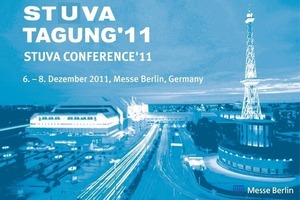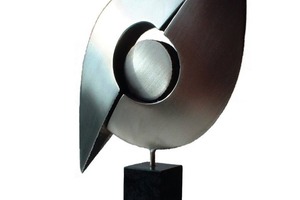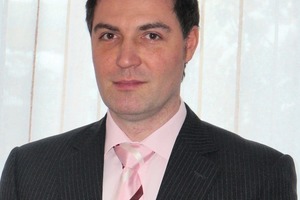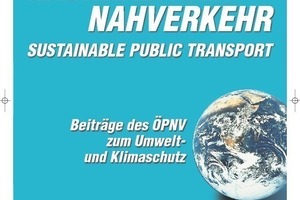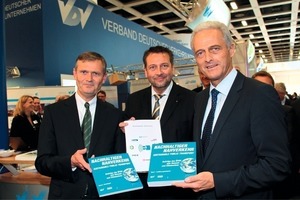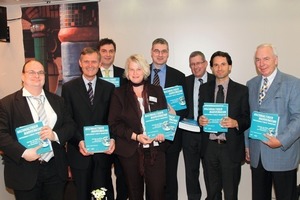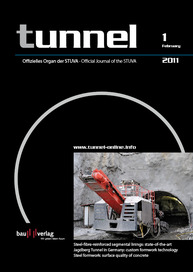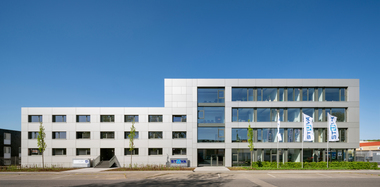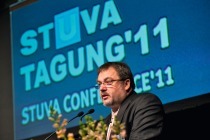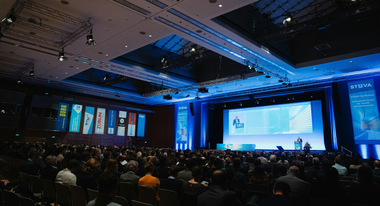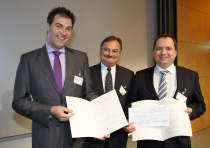STUVA news
STUVA Conference ´11
The next STUVA Conference is to be held at the Berlin exhibition centre from December 5 to 8, 2011 under the umbrella motto of „Underground Engineering for Sustainable Environmental and Climate Protection“.
The protection of the environment and the climate continues to gain ever greater social importance, the more so against the background of the world‘s progressively rising population: the number of people on our planet increases each year by some eighty million. In addition, by the year 2015 around 10 % of the urban population will live in mega-cities of more than 15 million inhabitants. The resultant expanded need for mobility can, due to the limited space available on the surface, predominantly be met only by means of underground transport systems. Increasingly great significance also attaches in this context to the conservation of energy resources, with the necessary attention to environmental and climate protection aspects.
Underground routings for the conveyance of both humans and goods ideally combine mobility with the safety of the environment and the climate. Repositioning transport facilities under the ground not only improves mobility - the concomitant reduction in traffic congestion also means less exhaust pollution and noise, making life on the Earth‘s surface considerably more pleasant. The land thus freed also opens up new perspectives in sustainable urban development.
On the criterion of environmental impact, overriding importance therefore attaches to underground construction in cities, large conurbations and topographically difficult locations. It is nonetheless apparent, at least in Germany, that approval and planning procedures have taken up an exceedingly long period of time in recent years, without the projects involved having then achieved the necessary acceptance in society by the time implementation starts (Figure 1).
New: Youth Forum
In the context of its series of papers celebrating its 50th anniversary, STUVA (the German Research Association for Underground Transportation Facilities) has for the first time provided young tunnel-engineering specialists with the opportunity, in its „Youth Forum“, of communicating the fascination of tunnel construction. In view of the large and positive response, such a forum has now, also for the first time, been included in the agenda of a „normal“ STUVA conference. The winner of the STUVA young talent prize will be selected from the speakers, with the award ceremony taking place in the context of the celebratory evening event.
The Call of Papers was sent to the STUVA members in mid-December, 2010, in the context of the preparations for the series of public addresses to be held on December 6 and 7, 2011.
Continuously updated information on the conference is available at www.stuva.de (menu item „STUVA Conference ‚11“).
The conference agenda, complete with registration forms, will probably be sent out in late May/early June, 2011.
Technical visits
Interested conference participants are invited to take part in visits to interesting project construction sites and transport facilities in Berlin and the surrounding area on December 8, 2011.
Specialist exhibition
STUVA conferences have been accompanied by specialist exhibitions since 1997. Thanks to the good response by exhibitors and conference participants, an exhibition is also planned for the 2011 event, and will be held on December 6 and 7. Exhibition Hall 20 has been reserved for this purpose (information is available at www.messe‑berlin.de, Download Centre; the papers will be presented in Hall 18, accessible via the North Entry through Hall 19).
The STUVA Prize
STUVA will, in the context of the STUVA Conference ‚11 in Berlin, be awarding the STUVA Prize ‚11 for notable innovations in the field of underground engineering (Figure 2).
In 1996, the STUVA board decided to finance a „STUVA Prize“ for outstanding innovations in underground construction, in order to promote the concept of utilising space underground both in the specialist sphere and among the public at large. This prize, taking the form of a sculpture, has been awarded every two years since 1997, in the context of a STUVA conference. The sculpture was created specially for this purpose by a well-known artist.
The prize is awarded to persons whose work is regarded as constituting a particularly significant innovation in the underground engineering sector and in relevant related fields. All underground engineering disciplines are covered, including planning, civil-engineering implementation, operation, safety matters, environmental protection, theory, testing and validation, cost-efficiency, financing and marketing. The „life‘s work“ of people who have exhibited particular merit in tunnel engineering, or in underground construction in general, and future-orientated projects, are also eligible for this distinction.
Previous winners have been:
1997 Senior Construction Director Rolf Bielecki
1999 Dipl.-Ing. Claus Becker
2001 Prof. Dr.-Ing. Wolfgang Brameshuber
2003 The NEAT project, Switzerland
2005 Dr.-Ing. E.h. Martin Herrenknecht
2007 The Betuwe Route project, in the Netherlands
2009 Prof. Dr.-Ing. Dr.-Ing. E. h. Heinz Duddeck
Candidates may put themselves forward, or be proposed by third-parties.
The following documents must be submitted to the STUVA office for this purpose:
A description of the innovation, its practical application and its benefits, or a statement of the candidate‘s significance for underground construction (maximum 10 pages, plus supplementary illustrative material)
Information on the copyright-holder of the innovation or details concerning the person, as relevant (CV, subdivided into headings)
The jury consists of the STUVA board:
Dipl.-Ing. Wolfgang Feldwisch
Prof. Dr.-Ing. Dr.-Ing. E. h.
Günter Girnau (honorary board member)
Dr.-Ing. Karl Morgen (1st deputy chairman)
Dipl.-Ing. Otto Schließler (2nd deputy chairman)
Dipl.-Ing. Edgar Schömig
Prof. Dr.-Ing. Martin Ziegler (Chairman)
The organisers reserve the right to consult external experts. The jury‘s‘ decision is final and binding.
Entries must be received by not later than July 31, 2011.
The award ceremony will be held on December 6, 2011 in the context of the opening of the STUVA Conference ‚11 at the Berlin Exhibition Centre. Your proposal or candidature would be most welcome.
STUVA engineer Dirk Boenke receives doctorate
After successful examination on December 15, 2010, Dr.-Ing. Dirk Boenke has been awarded a doctorate in Engineering Sciences. In his dissertation entitled „New methods for assurance of mobility for senior citizens in road transport“, he elaborated recommendations for action for the achievement at municipal level of transport planning meeting the needs of all generations.
The mobility of older citizens is steadily gaining in importance as a consequence of demographic, social and economic trends. It is therefore necessary to remember in the planning of transport infrastructures that aged persons are confronted more frequently than others with restrictions which impose limitations on their mobility. As they progress into old age, there is an ever greater probability that multiple physical problems will impair their mobility even further.
The law demands that the needs of all persons be taken into account in the utilisation of the road system. Legislation aimed at eliminating discrimination against disabled persons at both federal and state level, and the legislation derived from and influenced by it, requires easy and certain locatability, accessibility and usability of these facilities for all persons.
Analysis of the present situation, including more detailed reviews of current planning processes, indicated that the knowledge and experience necessary for the development and implementation of design solutions appropriate to all age groups are currently lacking in road-system planning and operation. Boenke structured his dissertation around relevant results obtained in the „Assurance of the mobility of older persons in road transport“ research project, which was performed on behalf of the Eugen-Otto-Butz Foundation, of Hilden, and in which Boenke played an important role (Figure 3).
The topic of this dissertation is also one of the fields for which Boenke is responsible at STUVA. As the leader of a group within the „Transport and Environment“ department, he works on the subjects of disabled-friendliness, mobility, and protection of the environment and the climate in local public transport. After completion of his studies at the Bergische University of Wuppertal, with prime emphasis on transport planning, Boenke initially worked in the field of transport planning and disabled-friendliness for the Planerbüro Südstadt consultancy in Cologne, subsequently returning to his alma mater as a scientific assistant in the department of Road Transport Planning and Technology. He joined STUVA in April, 2009, and is a member of German Road and Transportation Research Association (FGSV) Work Groups 2.5.3 „Disabled-friendly Transport Facilities“ and 1.1.10 „Local Mobility“ and is also active on the DIN „Basic principles for disabled-friendly design and accessibility“ committee. In co-operation with the Bergische University of Wuppertal, he also conducts training provisions for inspectors for trunk roads, access roads and main roads through built-up areas. He provided support, as a responsible project manager, for „Sustainable local transport - Contributions by local passenger transport to environmental and climate protection“, which was recently published as part of the „Blue Series“ of books issued by the Association of German Transport Companies.
New title in the VDV Blue Series - authored 100% by STUVA
In addition to the field of underground engineering, STUVA has also been active in rail and road transport matters for more than fifty years. The extensive knowledge acquired during this period was incorporated into the book „Sustainable local transport - Contributions by local passenger transport to environmental and climate protection“, published in September, 2010 as a new title in the VDV‘s „Blue Series“ (Figure 4).
This work reflects the social and economic requirement for mobility with simultaneous attention to environmental safety and sustainability. Published ahead of the InnoTrans, it was showcased for the first time at this international lead fair for rail-transport technology and presented by the VDV President, Jürgen Fenske, to the Federal Minister of Transport, Dr. Peter Ramsauer (Figure 5).
The book was compiled entirely by STUVA, with financial support from the Federal Ministry of Transport, Building and Urban Affairs. Figure 6 shows members of the project-support committee.
Local public transport possesses the great advantage that all essential elements (planning, construction, operation, staffing and financing) can be controlled, thus permitting the achievement of a harmonised overall concept. This two-volume publication, drafted in both German and English, provides transport operators and municipalities with a comprehensive aid for this structuring step. Volume 1, „Practical Examples“, lists in its eight chapters environmentally safe and energy-efficient potentials for the improvement of environmental and climate protection, citing specific examples from all sectors of local public transport. Numerous provisions relevant for future environmental and climate concepts in local public transport which have, however, remained restricted to only few specific applications up to now, or are still at the evaluation stage, are examined, in addition to widely implemented measures reflecting the current state-of-the-art. Each chapter closes with a brief summary, containing recommendations for action, with the inclusion of an assessment on the basis of the respective development status. The first volume concludes with summarising check-lists for each of the sectors.
Volume 2, „Fundamentals“, is devoted to problems, effects and conceptual solutions in the field of environmental and climate protection, both globally and - in view of the contribution made by local public transport - regionally and locally. The technological fundamentals in the energy-generation and energy-supply sectors, which are of particular importance for the future, are also analysed for the various energy sources (fossil fuels, nuclear energy, solar, wind and hydroelectric power, geothermics and biomass). The „Fundamentals“ volume concludes with an overview of the most important current European and German legal requirements and principles relating to environmental and climate protection.
New research project into the durability of transition points between differing sealing systems – STUVA participating in supporting workgroup
The Federal Institute for Research on Building, Urban Affairs and Spatial Planning (BBSR) is supporting a research project into the durability of transition points between differing sealing systems to be conducted by the Aachen Institute for Civil-Engineering Failure Research and Applied Building Physics (AIBau).
Differing sealing methods are, in practice, frequently combined with one another; horizontal surfaces on flat roofs, for instance, are installed using roof-sealing strips, and the edges sealed using liquid polymers, which provide easier workability. The rules of building technology currently do not require separate verification of the durability of the transitions between these systems. It has become apparent in the past, however, that these points constitute weaknesses and frequently fail shortly after the expiry of the guarantee period, causing problems for the building owner or operator. This research work is therefore aimed at determining rational and durable combinations of materials and installation methods for areas in which water accumulates.
The BBSR has set up a research-support workgroup to assist the research contractor. STUVA has decades of experience in the field of sealing technology, and is able to contribute its specialist knowledge systematically in this context. Director Dr.-Ing. Roland Leucker was therefore pleased to agree to the BBSR‘s request for STUVA‘s involvement.
DAUB recommendations for selection of tunnel-boring machines revised
The „Recommendations for selection of tunnel-boring machines“ drafted by the German Tunnelling Committee (DAUB) in 1997 have been revised. The new edition of this working aid redefines the fields of application of tunnel-boring machines and aligns the recommendations with current developments in the TBM sector.
The aim of the new recommendations is that of outlining bases for decision-making in the selection of tunnel-boring machines for use in rock and non-cohesive ground on process-engineering and geotechnical criteria. The correlations existing between the geotechnical, local and environmental boundary conditions and process- and mechanical engineering are also taken into account. The recommendations should be regarded as an aid to decision-making for engineers, and are not intended as a replacement for a project-specific analysis, which will, of course, continue to be the main basis for selection of a tunnel-boring machine. The new recommendations augment, in particular, DIN 18 312, „Underground Works“; VOB (German Construction Contracting Procedures) Part C.
The essential geotechnical characteristics variables are compiled for each specific process and for each machine type, and can be used as a guideline for selection of a TBM. Provided the key geotechnical parameters are known, an evaluation matrix in tabular form permits an extremely easy approximate assessment of the suitability of each type of machine. The qualitative suitability of a tunnel-boring machine is then depicted at three levels, with differentiation into principal applications, applications in which use of the machine is possible, and applications in which its use is at best borderline. Final selection of the most suitable type of machine is then performed on both environmental and economic factors.
The recommendations were first published in the „Tunnelbau 2011“ (Tunnel Engineering 2011) pocket manual, and are available for free-of-charge download from the DAUB homepage: www.daub-ita.de. They have also been incorporated into the second edition of „Mechanised Shield Tunnelling“ (Maschineller Tunnelbau im Schildvortrieb, Maidl et al.), to be published in January, 2011.

